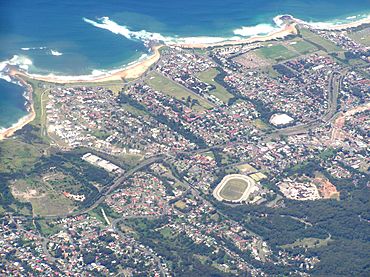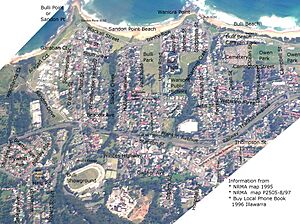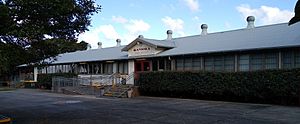Bulli, New South Wales facts for kids
Quick facts for kids BulliWollongong, New South Wales |
|||||||||||||||
|---|---|---|---|---|---|---|---|---|---|---|---|---|---|---|---|

Aerial view of Bulli
|
|||||||||||||||
| Population | 6,798 (2021 census) | ||||||||||||||
| Postcode(s) | 2516 | ||||||||||||||
| Elevation | 22 m (72 ft) | ||||||||||||||
| Location |
|
||||||||||||||
| LGA(s) | City of Wollongong | ||||||||||||||
| State electorate(s) |
|
||||||||||||||
| Federal Division(s) | Cunningham | ||||||||||||||
|
|||||||||||||||
Bulli (say "BULL-eye") is a suburb located north of Wollongong in New South Wales, Australia. It sits on the beautiful south coast.
Contents
A Look Back: Bulli's History
The name Bulli might come from an Aboriginal word meaning "double or two mountains."
Early Days and First Settlers
Long ago, the Dharawal Aboriginal people lived in this area. In 1770, Captain James Cook sailed past the coast. He tried to land but the waves were too big.
Around 1815, European woodcutters started working here. They cut down many Red Cedar trees, which were very common then. The first European to settle permanently was Cornelius O'Brien in 1823. He started a farm.
Did you know? The soil from Bulli is the main type of soil used at the Sydney Cricket Ground. This makes the cricket ground great for spin bowlers!
Bulli's Coal Mining Past
In 1862, the Bulli Coal Company opened a mine on the nearby mountainside. They built homes for the miners and their families. Coal was moved by train from the mine to Bulli Jetty. From there, it was loaded onto ships.
Miners were paid based on how much coal they dug, not a set wage. In 1879, the miners at Bulli formed the first workers' union in the Illawarra area. They wanted better conditions. The mine owners reacted by firing union miners and hiring new workers.
The Bulli Mine Disaster
A very sad event happened on March 23, 1887. A gas explosion in the mine killed 81 men and boys. This left 50 women without husbands and 150 children without fathers. Only one person survived, a 17-year-old boy known as "Boy Cope." You can find a memorial with the names of those who died in Park Road, Bulli. The mine reopened later that year. This disaster was the worst in Australia's history until 1902.
After the accident, an investigation found that safety rules were not followed. Gas was allowed to build up in the mine. This was because the air inside the mine was not moving properly. Also, when coal was removed, the empty areas were sealed off. This trapped dangerous gas.
Today, the old mine site has been flattened. You can still see some concrete foundations where buildings once stood. The old mine entrances are sealed with concrete. The railway line that carried coal to the coast is mostly gone. However, a bridge from the old railway is now a walkway over the highway. It has a sign welcoming people to the historic 'black diamond' district.
Who Lives in Bulli?
According to the 2021 census, Bulli has 6,798 people.
- About 2.8% of the people are Aboriginal and Torres Strait Islander.
- Most people (82.8%) were born in Australia.
- The next largest group (4.1%) was born in England.
- Most people (90.6%) speak only English at home.
- When asked about religion, many people said No Religion (47.4%). Others were Catholic (22.2%) or Anglican (14.5%).
Learning in Bulli: Schools
Bulli has several schools:
- Two public primary schools: Bulli Public School and Waniora Public School.
- One private primary school: St Joseph's Catholic Parish Primary.
- One public high school: Bulli High School.
Cool Places to Visit in Bulli
Bulli Beach is a popular spot for surfing. The northern part, called Sandon Point, often hosts surfing competitions.
The Bulli railway station is a historic landmark. It was the first train station on the south coast. It has a museum that is open every Sunday.
The Bulli Methodist Chapel opened in 1865. It became the Bulli Uniting Church in 1977.
Another old building is the Heritage Hotel, which opened in 1889. It is in the center of the 'Black Diamond' district.
The Illawarra Grevillea Park is a special garden that opened in 1993. It has a large collection of Australian native plants, especially grevilleas. Volunteers run the park, and it is open six weekends a year.
Behind the Grevillea Park is Slacky Flat Park. This park has some untouched rainforest and many native birds and marsupials.
Bulli also has a small shopping area with a newsagent and other stores.
Near Sandon Point, there is some bushland with turpentine trees. This area is important for birds that migrate. There is also a history walk where the old railway used to be. This spot also has an ancient Aboriginal shell midden.
Historic Sites in Bulli
Bulli has several places that are protected for their history:
- 240 Princes Highway: Heritage Hotel
- Northern Illawarra Uniting Church: Bulli Methodist Chapel
- Railway Street: Bulli railway station
Images for kids
-
Prostrate Cootamundra Wattle in Grevillea Park











